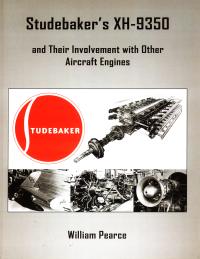
Studebaker’s XH-9350
and Their Involvement with Other Aircraft Engines
by William Pearce
Softbound, 8.5" x 11" x 0.56", 214 pages
ISBN-13: 978-0-985035-310
Old Machine Press (2018)
Recommended Retail Price: $19.99
154 black & white illustrations
Book Reviews 7
 |
Studebaker’s XH-9350 Softbound, 8.5" x 11" x 0.56", 214 pages Recommended Retail Price: $19.99 154 black & white illustrations |
Reviewed by Paul Christiansen - 18 Jun 2019
The author has provided a well written, comprehensive history on the background, development and ultimate outcome of this extremely large piston engine. The war outlook strongly indicated that very large aircraft would be needed if events turned against the allies. Born at a time when the outlook for long range aircraft demanded very high power, extremely low specific fuel consumption, along with the ability to fit within the leading edge of a wing, the XH-9350 was an attempt to fill the bill. Engines such as this would have been needed if the gas turbine engine had not come along. The company’s involvement in what would become the XH-9350 began when the Army, looking for someone to develop a 4,500 HP engine of very low fuel consumption and high specific output, found that existing wartime commitments by both the aircraft engine manufacturers and automobile companies producing aircraft engines under license were overwhelmed. The exception was Studebaker, who had the space and resources to undertake the project once an engineer qualified to lead the project was found. He arrived in the form of Norman N. Tilley, who had experience on the Lycoming XH-2470 and the Lawrence three cylinder auxiliary engine. Joining Studebaker, he helped build a proposal for the project in March, 1942 and work began shortly thereafter.
The story of the initial decisions as to cooling (liquid), aspiration (turbosupercharged), fuel system (injected) and propeller gearing (contra-rotating dual propellers) were decided upon. A program using single and dual cylinder test engines of 6.5”, 7.0”, 7.5” and 8.0” cylinder bore were to be built and testing in comparison of each other, along with various valve arrangements. The program is explained in detailed using the original test reports and correspondence as sources. With the final cylinder size decided upon, the engine’s detail “H” layout was being finalized when the war ended and the project stopped. All of this is explained clearly and with many very informative photographs to supplement the progress descriptions. All of the testing results are presented and the logic of the final cylinder and head layouts are supported in the text.
Also included are the prewar involvement of Studebaker in aviation projects, war time production of the Wright R-1820 under license and the post war production of the General Electric J47 turbojet.
Several very large piston engine projects were undertaken both in the USA and around the world during the war and shortly after, many of them never to be built, their development histories largely undocumented in detail, largely reduced to footnotes in the history books. In the case of the Studebaker XH-9350, the author is to be congratulated for giving us this well written in-depth history of this engine project. It fills yet another hole in the development of large piston engines in the nadir of the type. The book is well organized and an easy read, providing the background and positioning the project in the group of other very large engines that were under development and/or appeared in the same time frame for the same purpose. A full bibliography and Index are provided.
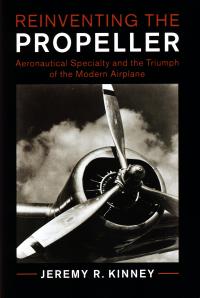 |
Reinenting the Propeller Hardbound, 6.3" x 9.4" x 1.1", 393 pages Recommended Retail Price: $120.00 25 b/w illustrations, 4 tables |
Reviewed by Kimble D. McCutcheon - 1 May 2017
This book has nearly everything a propulsion book ought to have. It covers visionaries, inventors and manufacturers that developed and produced modern propellers, and explores the propeller's impact upon the world.
Kinney introduces us to Frank W. Caldwell, who as the civilian head of the U.S. Army Air Service Engineering Division Propeller Unit, shaped the future of American propeller development. Caldwell's WWI experience had convinced him that wood was not a suitable material for increasingly higher aircraft power and speed. Under his leadership, the world's first dedicated propeller whirl testing facility was built at McCook Field, near Dayton, Ohio. Here, propeller specialists could spin large propellers to destruction at speeds far higher than they would ever see in service. This promoted the investigation of propeller materials, construction and mechanisms.
The NACA conducted civilian propeller research. William F. Durand and Everett P. Leslie at Stanford University, and Fred E. Weick at the Langley Memorial Aeronautical Laboratory developed theoretical propeller performance models that were correlated to wind tunnel test data. NACA opened its full size Propeller Research Tunnel at Langley in 1927 under Weick's direction. In addition to its important role in verifying propeller theory, the Propeller Tunnel also facilitated development of the NACA cowling and the integration of the propeller, cowling and nacelle into aircraft wings and fuselages.
Propeller construction evolved from fixed-pitch to ground-adjustable to variable-pitch to constant speed. Materials evolved from wood to solid aluminum to hollow steel, and finally, in the 21st century, to carbon fiber/Kevlar composites. Each of these had its promoters and detractors. Kinney covers the people and major U.S. (Hamilton Standard, Curtiss Electric, Aeroproducts), British (de Havilland, Rotol) and German (VDM) companies that supplied large propellers.
Kinney also explores the surprising reluctance of the American and British aircraft industries to embrace variable-pitch and constant-speed propellers, primarily due to concern over increased weight and complexity. The tide turned in the U.S. when aircraft capable of coast-to-coast air service needed to operate from high-altitude airports and continue to climb if one engine failed; this led to nearly universal adoption of constant-speed propellers for U.S. airlines in the mid-1930s. The British were much slower to install constant-speed propellers, and only after witnessing poor performance of British aircraft against German aircraft with VDM constant-speed propellers did Fighter Command embark on a crash program to install propeller governors. In just 44 days about 300 Spitfires underwent 15 to 20 hour retrofit procedures, making them competitive with Bf 109s just in time for the Battle of Britain.
Propellers took a back seat to jet propulsion after WWII, but despite the popularity and efficiency of turbofans, propellers still fill important niches in general aviation, specialty military and civilian transport aircraft.
This is a book that is hard to put down. It relates the rich history of a specialized technology in an interesting and engaging manner. It is so meticulously documented that the notes alone are worth the book's price. Essays on sources acquaint the reader with archives and other information repositories that could facilitate further research, and an extensive index helps to rapidly locate technologies, organizations and people. Kinney's book excels on many levels and is a welcome addition to this reviewer's library.
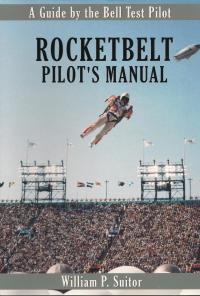 |
Rocketbelt Pilot's Manual Softbound, 7" x 10" x 0.3", 106 pages Recommended Retail Price: $22.95 128 pictures/diagrams, black and white |
Reviewed by Tom Fey
For those old enough to remember James Bond taking flight in Thunderball (1965), dueling pilots at the first Super Bowl (1967), or the opening ceremonies of the 1984 Los Angeles Olympics, rocketbelt flight has always been a mesmerizing event. The technology of the rocketbelt and the unblemished safety record of the Bell Rocketbelts (others have constructed successful units) are amazing accomplishments, considering the unit has no lifting surfaces, no more than 21.5 seconds of powered flight per session, generates 1,000 horsepower, 330 lbs of thrust from 110 lbs take-off weight, and exhaust temperature over 1,300°F.
Bill Suitor flew all three of the aforementioned events, and well over a thousand flights altogether. Through photographs, drawings, and descriptions with an easily understood vocabulary, the author takes you step by step through the belt itself, showing the early "cold thrust" test rigs, the rocket engine, peroxide fuels, flight system mechanics, tethered flight, and the actions required to successfully plan and execute a rocketbelt flight. This was all bellcrank, cable, and pilot judgment technology; no gyros, data displays, or radio communication. Suitor nicely credits the Bell pioneers and patent holders for the technology, with many photographs of these men and the varied iterations of the technology that were prototyped in the 1960s.
Thought I'd never see book about this amazing "aircraft" engine, but Suitor comes through with a nice work on a truly amazing flight propulsion system. Highly recommended.
 |
The V12 Engine Hardcover, 210mm x 270mm x 28mm, 424 pages Recommended Retail Price: £40.00 350 b/w, 32 color illustrations |
Reviewed by Doug Culy
Ludvigsen covers 100 years of V12 engine development, focusing on race car engines, sports car engines, sedan engines, and aircraft engines in that order. The index shows that over 400 different engines are discussed. Some engines merit four or more pages, some get only a paragraph. There are many photos and line drawings, as well as accounts of people, cars, and companies. Individual engine stories are full of details on all aspects of engine design. Overall The V12 Engine is an outstanding presentation of just about all that you would want to know about an obviously fascinating engine layout; and is a follow-on to the smaller but equally excellent book of his, Classic Racing Engines. This reviewer is of the opinion that aircraft engine development and race car engine development have more similarity of challenges than differences, so The V12 Engine is well worth its price. Mr. Ludvigsen is also a member of the AEHS.
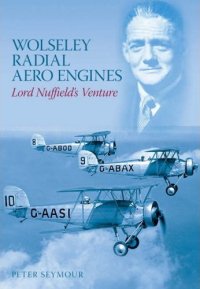 |
Wolseley Radial Aero Engines Soft Cover, 25 x 17cm, 192 pages Recommended Retail Price £18.99 Many illustrations (all b&w) |
Review by Jerry Wells
This book gets off to a bad start with me because of the title—not only is it long-winded but it is also prejudicial. If the author feels that the project by Lord Nuffield (actual name, William Richard Morris) to produce aero-engines was thwarted, then surely it is up to him to put his case in the text of the book and enunciate his conclusions at the end, leaving the reader to make his own final judgment on the matter. As it is, the author's opinion is telegraphed on the cover and all the title pages. An American book I purchased a few years ago called, The History of Aircraft Gas Turbine Engine Development in the U.S. - A Tradition of Excellence has the same problem.
Nonetheless, Wolseley Radial Aero Engines is a welcome addition to the aero-engine literature and it gives great detail as to the origins, development and production of engines by a niche manufacturer.
Preceding Chapter 1 is a three page chronological list giving brief details of the history of the Wolseley name from 1837 to 1938 thus allowing the reader to obtain an overview of the story, if he so desires.
Chapter 1 covers the history of the Wolseley Company from its origins in Australia to motor car production in England, including aero-engine manufacture before and during WW1. The Company went bankrupt in 1926 and was purchased by Lord Nuffield to prevent it falling into the hands of foreigners.
Chapter 2 describes how Lord Nuffield decided to use the Wolseley Motors concern to produce a range of radial engines for the private aviation market which he judged to be something that would develop strongly in the 1930s. This chapter also contains an excellent section giving technical description, drawings and photos of all the Wolseley aero-engines.
Chapter 4 is pivotal to the story of Wolseley aero-engines. It is titled, "The Market for Wolseley Aero Engines" and the situation is summed up by Seymour's comment on page 76, "The opportunity to sell aircraft engines in quantity for privately owned aircraft which Lord Nuffield had anticipated in 1929 had not, therefore, materialized … so Wolseley found it very difficult to find a market for its aero-engines … ,etc."
Having got himself into this situation, Lord Nuffield tried to remedy matters a) by selling his engines to the military and b) by selling the whole factory to the government. The Wolseley engines, which were small capacity, low horsepower, utterly conventional radials, had nothing to offer the R.A.F. and, quite understandably, were rejected by the Air Ministry. This soured Lord Nuffield's relationship with the Air Ministry and led to his exclusion from the important Shadow Factory scheme.
Chapter 6 recounts the story of how a pre-war proposal to fit Wolseley radial engines to the Airspeed "Oxford" training aircraft came to nothing due to more disagreement between the egregious baron and the government. He had learned nothing from past experience. This was the end of Wolseley Aero Engines Ltd.
The remaining four chapters deal with aspects that are somewhat tangential to the subject of this book, including the establishment of the Castle Bromwich "Spitfire" factory near Birmingham in 1938. Lord Nuffield was invited by Air Minister Kingsley Wood to manage this on behalf of the government. However, Lord Beaverbrook, just three days after his appointment as Minister of Aircraft Production, sacked him in May, 1940!
A number of Appendices complete this book. These cover all sorts of interesting aspects such as personality profiles, engine statistics, test flight data, etc.
Wolseley Radial Aero Engines is a nice-sized book, printed on good quality paper and very well illustrated. I didn't like the small, spidery text style; sure, it's readable but very few people would find it easy reading and what is worse is that the quotations (which are extensive) are printed in a text size which is about half that of the (already small) main text. What's wrong with quotation marks? This is just ridiculous computer gimmickry. The script is also unnecessarily cramped and run together. Publishers should realize that books such as this are discretionary reading; they are not technical course books. If they are not easy to read, people just won't bother - hence the popularity of TV! I note the advertising "blurb" on the back cover is printed (surprise, surprise!) in large, bold text!
In conclusion, faults aside, this little book is an essential addition to the aero-engine enthusiast's library and the author is to be congratulated on his efforts to record and publish this piece of history.
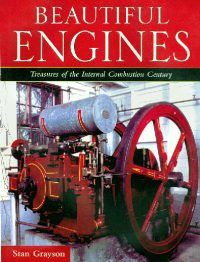 |
Beautiful Engines Hard Cover with Dust Jacket, 8.5 x 11.5, 112 pages List Price US $49.95 Approximately 84 color and 46 b/w images |
Review by Allan McGuinness
If ever there was a book with a misleading title this is it. Sure it is a lovely coffee table book. Large format, hard cover, full colour, "Treasures of the Internal Combustion Century" is its secondary title. Be in for a surprise. The "treasures" are an example of almost every important engine that provided the necessary technical advances that prepared the way for the 20th century to be called the "internal combustion century". Over half the book is devoted to engines made in the 19th century, and not only do we get them in full colour we are also told how they work with explanatory sectional drawings of the early slide valves and descriptions of their ignition systems. Added to this are comments on the designers, the manufacturers and their future place in the scheme of engine production. We are told where they are and they are not all American, they are French, German and English before we get to the American ones. Even then we get East coast, West coast and the ones in between.
I was fascinated by the very early technology and found the later, industrial and marine engines just as interesting because they show advances and not just 'coffee table' images. Overall, what a pleasant surprise and not expensive either.
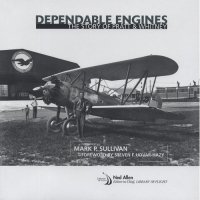 |
Dependable Engines Hardback, 260mm x 260mm x 20mm, 164 pages Recommended Retail Price: $29.95 Photos, some color |
Reviewed by Doug Culy
Mark Sullivan’s book on P&WA has many pictures not seen before in books on this great engine manufacturer. It focuses on the last 50 years of the company’s 85-plus-year history, and brings the reader right up to 2008. The first four chapters deal with the piston engine era, with the next eleven chapters covering jets, rockets, etc. No specific information on piston engine development, but, some new insights on the big commercial fan engine programs of the current era. Included is a timeline from August 1925 to February 2008 that has many useful dates.
The author was Director of Media Relations for P&WA in recent years, and compiled this book largely from the archives of the company, which include the company’s monthly newspaper/newsletter, press releases, and some magazine articles. The author cites about a dozen independent books on P&W people and engines. Canadian P&W is sufficiently covered, but the reader is referred to CP&W’s own history for all details, which is offered by a Canadian publisher. The rocket engines are covered just enough to make the reader hungry for more detail, but that is better than not at all.
This is not a technically-oriented book, such as The Engines of Pratt & Whitney (also recently published) and is smaller, having only 164 pages. Sullivan’s time at P&WA began in 1980 and ended in 2007 or 08, while Jack Connors’, the author of The Engines of Pratt & Whitney joined the company in 1948 and retired around 1990.
However, this reviewer found much new information, one surprising revelation, and several hoped-for revelations, making Dependable Engines a valuable complement to all previous books on the company. Its printing and binding are well done.